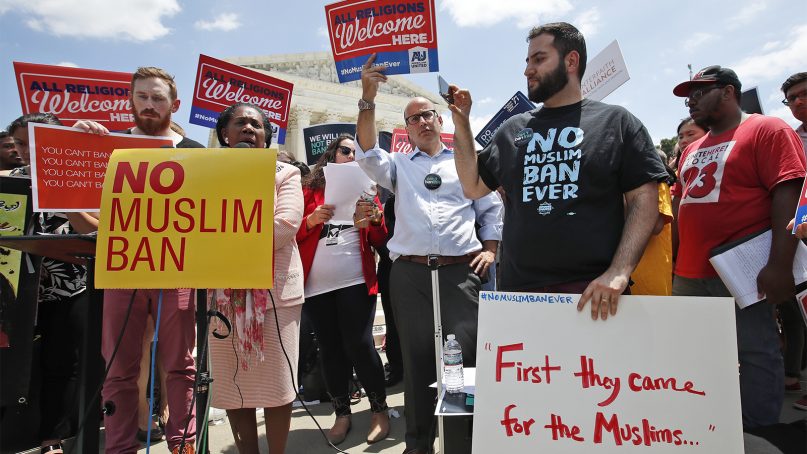(RNS) — Whether viewed in terms of contemporary politics or American history, the Supreme Court’s ruling on President Trump’s travel ban against several Muslim-majority countries is not surprising. The court has safeguards designed to make it apolitical, but it is never immune to its immediate surroundings on Capitol Hill. Historically, as long as the people support its decisions, the court has ruled in favor of discrimination.
And when it comes to admitting people to these shores and welcoming them to the American nation, the court almost never acts for the rights promised in the U.S. Constitution without first denying them.
In Ozawa v. United States in 1922, the court, citing the Naturalization Act of 1906, refused a Japanese-born man citizenship on the grounds that he was not white. The following year, in the Thind decision, the court effectively stripped Indian-Americans of their citizenship. Bhagat Singh Thind had argued from a scientific viewpoint that Indians and Caucasians were of the same race; the court opted for what it called a more “common-sense” definition of whiteness.
More recently, in the living memory of many Americans, was Korematsu v. United States, in which the court ruled that sending Japanese-American citizens to internment camps for the duration of World War II was legal. The decision said the president of the United States could target a group of people based on a defining characteristic and imprison them for national security reasons and without cause.
This is the same passion for expediency in racial classification that has allowed citizens of five Muslim-majority nations to be prevented from traveling to the United States (out of seven countries included in the ban). Though Islam is a faith, and Muslims make up one of the most racially diverse religions in the world (indeed in the United States), Muslims have been “racialized”: bound together and stereotyped.
This perception of Muslims as a racial community was revived in recent history by the 1979 Iranian Revolution and the attacks of 9/11. These events instilled an idea of Muslims as a foreign threat and brown-skinned.
But the confusion goes back to the United States’ beginnings, when Muslims were often referred to as Turks — members of a horde that threatened white Europe from the East — even though up to a third of all enslaved people living here were Muslim.
The racialization of Muslims is visible in the way many Americans tend to regard anyone from South Asia or the Arab world as Muslim. Hindus, Sikhs and other non-Muslims are often the targets of anti-Muslim hate crimes — despite the fact that the largest group of Muslims in this country is black.
The confusion persists even though Muslims make up about 1 percent of the U.S. population. They operate in highly visible, critical parts of American society. They are cabdrivers and doctors. They have been doing this work for generations.
Despite Muslims’ diversity, they fit into the larger pattern of American racial exclusion, on which the justices’ record is not good: The Dred Scott decision in 1857 ruled that human beings are property; Plessy v. Ferguson, in 1896, established the notion of “separate but equal.” The country has long used —and the Supreme Court has legitimized — policies of family separation and incarceration against enslaved peoples and Native Americans.
American history is Muslim history, is Black history, is Native history, is Latino history, and that history has often been the story of keeping us from seeing our connections to each other.
Trump’s edict may be legal, in other words, but it is nonsensical. It serves no national security interest. It demonstrates a lack of understanding of immigration, tourism and asylum-seeking. The countries targeted in the proclamation are refugee-rich countries, which we have legal and moral obligations to assist.
By muddying the issue of who these people are — asylum-seekers and job-seekers, not terrorists or criminals — Trump seeks to deny America’s obligations, both worldly and spiritual. It is the same tactic he deploys against asylum-seekers on our southern border. We cannot see the treatment of human beings at borders as being different; whether from the South or the East, these are people who will die without our aid.
As a Muslim, I’ve been taught an important religious principle: repentance. When we make a error, especially one that hurts someone, we are charged with apologizing, then turning away from the behavior. As an American, I know we spend a lot of time saying “sorry” for our racism, but we have not repented from it.
To free ourselves from it, we need to repent, we need to remember, and we need to re-create how we see ourselves. We have to have a different political will.
Until then, the Supreme Court will continue to legitimize racist laws and presidential statements.
(Hussein Rashid is an adjunct faculty member at Barnard College and a Truman National Security Fellow. The views expressed in this commentary do not necessarily reflect those of Religion News Service.)





